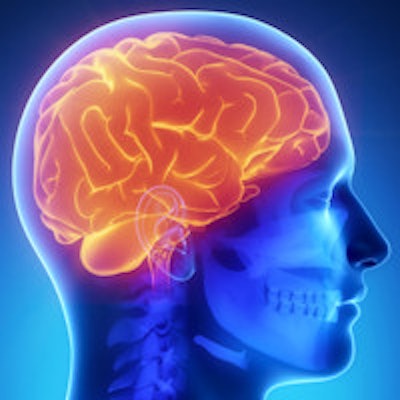
Patients with newly diagnosed lung cancer don't need brain scans, but they get them anyway, according to a new study in the April edition of Chest that examined patients diagnosed with non-small cell lung cancer (NSCLC) as part of the National Lung Screening Trial (NLST).
Researchers from the University of California, Los Angeles (UCLA) examined NLST patients with clinical stage IA NSCLC who received CT or MRI scans within 60 days of diagnosis, but before surgical staging. One in eight had undergone CT or MRI of the brain to rule out metastases, despite a Choosing Wisely recommendation against the scans.
"We found that 12% of the patients underwent brain imaging and none of them ultimately had any brain metastases," said Dr. Alex Balekian in an interview. "Only two patients were upstaged to stage IV, and those were not brain metastases."
Brain mets are rare
Prior studies of stage I NSCLC patients have shown that asymptomatic brain metastases occur rarely, wrote Balekian and colleagues Joshua Fisher and Dr. Michael Gould from UCLA's Keck School of Medicine in Los Angeles.
For example, a 1999 study from Japan (Tanaka et al, Annals of Thoracic Surgery) reported a 0.5% prevalence of brain metastases in early-stage NSCLC, only a third of which were asymptomatic. The study showed significant cost savings when unnecessary brain imaging was eliminated, and it formed the basis for Image Wisely recommendations from the Society of Thoracic Surgeons. Still, prospective multicenter studies examining the use of imaging in this population are lacking.
So, the authors wanted to investigate the frequency of brain imaging in patients with early-stage NSCLC enrolled in NLST, with the hope of identifying clinical or demographic factors associated with undergoing brain imaging and to describe the frequency of occult metastatic spread in this population (Chest, April 2016, Vol. 149:4, pp. 943-950).
The 2011 National Lung Screening Trial screened more than 53,000 asymptomatic adults with a smoking history of 30 pack-years or more in three annual screening rounds.
Balekian et al included patients with a histological diagnosis of stage IA NSCLC (maximum tumor diameter, 3 mm), excluding those with advanced disease, multiple sequential lung cancers, or cancers that could not be staged via tumor-node-metastasis (TNM) classification.
They studied patients who underwent brain imaging with CT or MRI within 60 days after lung cancer diagnosis but before any surgical sampling or resection. As for MR or CT, several patients had more than one brain scan, but about half the patients received one modality and half had the other, Balekian said.
Self-reported age, sex, race, and number of pack-years were recorded along with lesion size, NLST study arm (whether screening was performed with CT or chest x-ray), and whether or not the cancer was discovered at screening, the authors wrote.
The researchers wanted to see which factors would best predict which NLST subjects would get brain imaging, so they created two multivariate logistic regression models -- one describing lung tumor size continuously and the other categorically. Because imaging centers were not identified, clustering by study site was modeled as a random effect.
Who got brain scans
The results showed that among 643 patients with clinical stage IA NSCLC (T1N0M0 or T1N0MX), 77 (12%) underwent at least one brain imaging study. Patients (median age, 64 years) tended to be male (54%) and white (91%), had a median smoking history of 55 pack-years, and had a median tumor size of 15 mm.
CT screening detected their lung cancers in 65% of cases; 66% were identified within the low-dose CT screening program, the authors wrote. Eighty percent of the patients (n = 516) underwent surgery with curative intent.
"The staging of NSCLC is fairly complicated and requires a lot of different disciplines and tests because of the complexity of disease; certain tests and procedures are overkill and some are absolutely necessary," Balekian said.
Avoiding unnecessary scans
Choosing Wisely emphasizes the need to avoid unnecessary scans, including avoiding brain scans in newly diagnosed NSCLC unless neurological symptoms are present. This is because of the extremely low rate of distant metastases to the brain.
"What was really interesting was the variation among centers," Balekian said. While some of the 33 centers held fast and didn't do any brain scans, one center performed them in 80% of their patients. The center with the largest volume logged brain scans in about 15% of its patients, above the mean 12% rate.
"It would be great if we could cut away at that 12% waste," he said.
But in defense of the clinicians who ordered brain scans, he noted that "the Choosing Wisely recommendations came out in the middle of the [NLST] study." Still, the 1999 study on which the recommendation was based was available throughout NLST.
Another limitation of the current study was that the lack of neurological symptoms couldn't be verified. But if any individuals did have symptoms, "those symptoms were not due to brain metastases because everybody who got brain imaging went on to get surgery," Balekian said. "You wouldn't operate on them if something abnormal was seen in the brain scan."
Who was more likely to get brain imaging? Multivariate analysis showed that older patients (65-69 years; odds ratio [OR], 2.78; p < 0.01) and patients with larger primary tumors (> 20 mm; OR, 2.50; p < 0.001) were more likely to undergo brain imaging, "but these relationships were not linear," the authors wrote.
The study's apparent threshold of at least 20 mm for more frequent brain imaging has some support in prior studies that showed different survival rates for different tumor sizes, they acknowledged.
But foregoing brain scans seems reasonable for the tumors analyzed in the study, all of which were 30 mm or smaller, and the study supports the view that brain imaging isn't helpful in asymptomatic patients with stage I NSCLC, the authors wrote.
"We've essentially recreated the Japanese study that shows that there's an extremely low rate of unexpected metastases outside of the chest, even in the brain, for stage IA lung cancer patients, and brain imaging should not be done," Balekian said, though later-stage cancers are a different story entirely.
Not for more serious cancers
An accompanying editorial by Dr. David Ost from the University of Texas underscored the point that the findings don't extend to more advanced cancers at stage IB or II.
Patients with large adenocarcinomas with N1 disease may have a high enough pretest probability even with a negative clinical examination to warrant brain imaging, Ost wrote, noting that the National Comprehensive Cancer Network guidelines recommend brain MRI for stage IB (recommendation category 2B) and stages II and IIIA (category 2A). Future studies will determine whether brain imaging is appropriate in asymptomatic patients with clinical stages IB and II disease.
"Once the evidence base is strong, standardization will be more effective," Ost concluded. "Without a strong evidence base, however, unwarranted monitoring for adherence to weak guidelines would be counterproductive, wasteful of resources, and unwise."
Going forward, the group "will continue to look for variations in care and any health disparities in NLST," Balekian said.




















